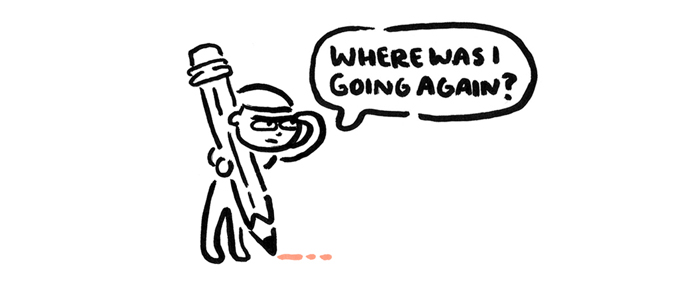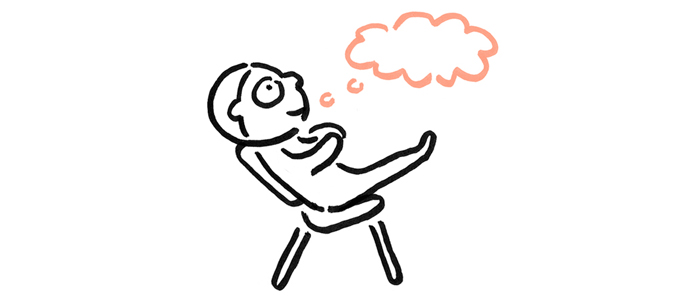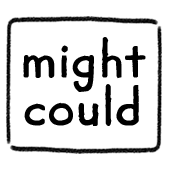
There are two mindsets involved in creativity: Ideation and Production.
The Production mindset is about doing the work. This is where we do the bulk of the making in art making. We know what we’re doing, where we’re going, and it’s only a matter of following through. This is where we set goals and deadlines. This is where we get into the nitty gritty. This is where we see that book project through to completion. This is where we are most effective and efficient. This is where we finish.
But finishing is the easy part. The hard part is beginning.
The Ideation mindset is about finding our ideas. This is where we do the bulk of the art in art making. We don’t know what we’re doing, where we’re going, and it’s only a matter of figuring out what it all could possibly mean. This is the meandering, exploratory, playful side of art making. This is where we wander around confused, but continue along anyways. This is where the idea for that book is discovered. This is where we are most creative and original. This is where we begin.

Addicted to Productivity
Lately, it feels like we’ve all become addicted to the Production mindset. We want everything we do to have a purpose. We want clear to-do lists and goals to follow. We want to be more efficient. We want everything to be monetized. We want to achieve. We want to finish.
“There was formerly a capacity for light-heartedness and play which has been to some extent inhibited by the cult of efficiency.”
–Bertrand Russell, philosopher, writer, and Nobel laureate
But before we can finish, we have to begin.
And where to begin?
We have to prioritize time for Ideation first. We have to give ourselves time to draw for no clear purpose—just to draw. That’s where the creative magic happens. That is where we find our ideas, and speak with our voice.
Production is where we make our art. But Ideation is where we discover our art.
And that’s where your sketchbook comes in.

Drawing, Just to Draw
When we draw with a defined goal or specific purpose, we limit ourselves to that one possibility. We’re in Production mode, and we’ve narrowed and closed off our mind to achieve that goal. This is where we want to be when we are finishing our art.

A sketchbook, on the other hand, is where we begin our art. Here, we can sink into the Ideation state of mind. It’s a place to draw for no reason, goal, or purpose, other than just to draw. Our sketchbook opens up endless possibilities, and allows us to slow down and get off the hamster wheel of production. Our sketchbook encourages us to open ourselves up and see where it leads us.

We still, of course, need the Production mindset to create our art. Otherwise we’ll be full of ideas, but never bring any them to fruition. But I think we’ve become obsessed with the Production phase of creativity, and we’ve forgotten how important the Ideation phase is.
We have to allow ourselves to occasionally slow down, and wander in our art. Opening up and letting go of expectations are essential to art making.

We have to be able to tap into that sense of idleness and wander around the page without a destination in mind. We have to embrace chance. We have to momentarily throw out the ideas of effectiveness, efficiency, and end products. They’ll come back into the process later, but in the beginning, we need to just draw.
The Production mindset is extremely vital for improving technique, seeing goals through, and completing projects. But having a mindset of improvement and efficiency is detrimental to creativity and coming up with original ideas. We have to be able to tap into both creative mindsets.

The Journey + The Destination
The Production mindset will get you from point A to point B in the quickest, most efficient way possible. That’s wonderful for completing a creative project, but it doesn’t work for beginning a creative project. Creativity isn’t about the final destination, it’s about the entire journey.
“The power of a country road is different when one is walking along it from when one is flying over it by airplane.”
–Walter Benjamin, writer
We often don’t even know what the Point B destination is when we begin! We have to be willing to begin the journey without knowing the destination, and go on the journey just for the sake of it.

If we set off on the journey with a predetermined destination, that’s the only place we’ll ever get. Who knows where we could have ended up if we had left the possibilities open? We learn and see so much more when we embark on the journey with an open mind, rather than narrowing our focus on the destination from the start. We have to begin with Ideation.
What we’re really doing in the Ideation mindset—when we draw for the sake of drawing or make art with no purpose in mind—is allowing ourselves to get lost.

New Connections
The ironic thing about all this, is that in getting lost—in setting out to create art with no purpose—we often stumble onto our destination. We play. We experiment. We explore. And while we’re out there wandering aimlessly on the page, things begin to connect. We start with nothing, and somehow, that nothing turns to something. Something new. We begin to make new connections.
And those connections lead us to an idea so much more meaningful, original, and imaginative than if we had set out with a fixed, predetermined destination from the beginning.

If we can just allow ourselves to stop focusing so much on end goals, effectiveness, and answers, we can turn off our Production mindset.
And if we can then allow ourselves to focus on relaxing, opening up, and exploring, creativity and original ideas will bubble up in the pages of our sketchbook.
This is where we discover our most original insights.
That is where we discover our art.

A Balanced Partnership
We need both Production and Ideation to make our art, and we have to learn to balance the two. We have to turn one mindset off to tune into the other. We have to balance our ambition with relaxation. We have to balance work with play.
We tap into our Ideation mindset of play and exploration to begin, and then we follow it with the Production mindset to finish, going back and forth between the two as needed.
There are two mindsets involved in creativity, and it takes both to make art.


